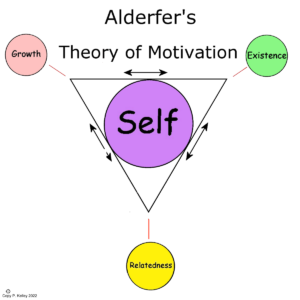
Alderfer’s “A Theory of Human Motivation”
Through life, we collect volumes of assumptions and stereotypes learned through education and personal experience. You name it, assumptions are everywhere around us, in everything we do and say, every single moment of the day.
Assumption and stereotype are survival mechanisms.
Survival of the species depends upon instant access to past learned experiences and assumptions so we may make “duck, run for cover or grab the last slice of pizza before that other guy does” type of decisions.
Assumptions and stereotypes are good, bad and ugly things which depend upon amount and degree of pre-learned BS. Assume and stereotype all you want, guilt-free. It’s impossible to stop to research on the fly and live a normal life in the process. Assume the day will be a good one. The odds of anything going bad on a sunny day, blue sky and warm breeze…a paranoid stereotypical horror story
Stereotyping fast-tracks response time, but both assists and interferes with interpersonal and community, social interactions.
Paraphrase Maslow: The function of education is to neutralize apparent dangers through knowledge.
- “We am not afraid of thunder because we know something about thunder”
Lightening, on the other hand…one one-thousand…two one-thousand…
Assumptions
“Wethern’s Law of Suspended Judgement: assumption is the mother of all screwups.“ —Mark Mills, The Information Officer (2010).
Assumption: the belief that something is true based on tenuous or no evidence. To take something for granted or expect something without consideration of evidence.
Stories, folklore, myths & legends, movies, TV and videos all ascribe assumed qualities and characteristics to create assumptions and reinforce stereotypes.
Assumptions are stored in memory as stereotypes along side associated thoughts and memories. Once the notion settled in, we go into auto pilot until a bonefide V8 forehead slap paradigm shift occurs.
Stereotypes R-US
Stereotype: positive or negative, an oversimplified image or idea often based on assumptions, Sociology. a simplified and standardized conception or image.
Common Stereotype Topics
Ya, the crazy train. The pot stirs. The unanswerable, unsolvable questions and issues so necessary for (all of the above) to challenge the status quo and trigger hot buttons which rile up the natives, loosen wallets and create hate and discontent.
These are the Wicked Questions concealed within the Wicked Problems.
- Adoption
- Sex
- Marriage
- Men
- Children
- Women
- Abortion
- Religion
- Race
- Politics
The divisive targeting of synergetic marketing doesn’t stop at the big 10. Humans naturally create assumptions and stereotypes about literally everything and anything, therefore literally anything and everything is under constant bombardment by government, media, Internet, TV, radio, books, advertising, movies, film industry, type casting, sound track, wardrobe, music, simplistic plots, formula stories, ideologically packed, homoginized casting…
Tactics include the use of psychology to target the senses, humor, sexuality, insecurity, rear, pseudoscience, etc.
- Off-key, sad music transforms into melodious happy tune when cure/idea/cause/product introduced
- Drums, flute, chopsticks, gongs eastern, orient ethnic assumption
- wise seer, usually old, blind or lame and harmless
- digeriedoo, harmonica, guitar, piano western flair
- southern theme banjo – car chases, bar fights
- ignorance through accents – the southier the stupider the more euroidite the smartest the charactor
2-D Thinking
Synergetic media introduces assumption & stereotyping as opposing and separate cause and effect entities when they are one in the same, created through tenuous evidence and oversimplified into an image or idea.
Media, government, entertainment, advertisers, religious & secular ideologies and all mentioned above, push and pull to reinforce and admonish stereotyping assumptions to suit their intentions.
- right vs left – choose between lesser of two evils
- bad vs good – choose between lesser of two evils
- fear vs safety – choose between certain, impending doom and product xyz
The only things that can change the cycle include Maslow’s Theory of Human Motivation.
- Existence – Awareness
- Relatedness – social
- Growth – Curiosity, willingness to learn
Change is Easy – Right?
Change is gradual to where one doesn’t notice, change is also abrupt, but change always happens. None of us are the same person we were 20 years ago or 3 years ago, or last month.
We hope to be a different person tomorrow because that means we would have learned a thing or two about existence and our importance to the universe or lack thereof.
But Change is Not Easy
Synergetic media targets our minds and senses on multiple levels, visual, audio, sound, illusion to effectively reinforce or weaken the image or idea in our pointy little heads.
Hopefully we all have changed many assumptions and stereotypes throughout the course of our lives. In addition to the BIG ones media constantly throws in our faces:\
